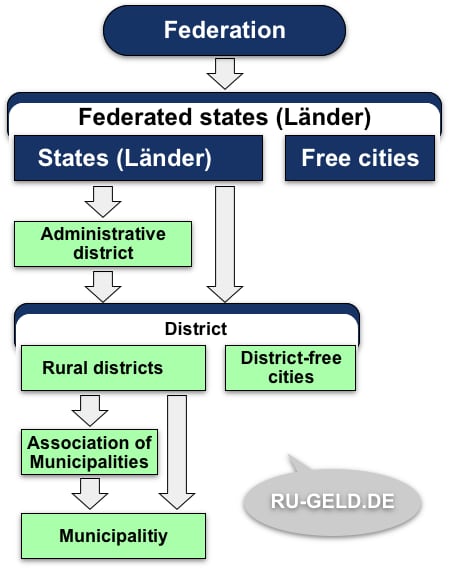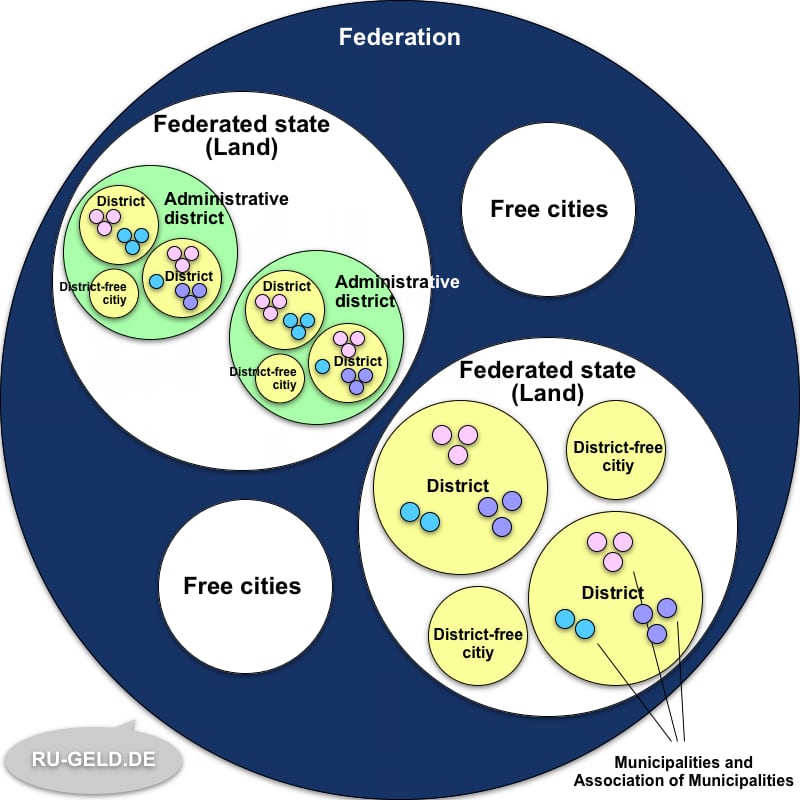Administrative and territorial structure of Germany as of 2025: form of structure, territorial units, divisions, list of federated states(lands) and districts
§ Form of administrative and territorial structure of Germany
Federation
The form of state structure in Germany is a federal state or federation. This form of government implies the unification within the state of several subjects of the federation (lands, republics, provinces, states, parts) that have broad political rights and freedoms, but do not have state sovereignty. Thus, the federation is the highest level in the hierarchy of the state structure of the country. The federal level in Germany is represented by the following authorities:
- the Government headed by the Federal Chancellor;
- the Bundestag or the Parliament;
- the Bundesrat;
- the President of Germany;
- the Federal Assembly;
- the Joint Committee;
- the Constitutional Court.
For more information about the federal authorities see a dedicated page of our website.
Federated states (Länder) of Germany
The next level in the state structure of the country is represented by the Länder of Germany or the federated states - these are the subjects of the Federation with broad powers in their domestic policies and territorial structure. In total there are 16 subjects of the Federation in Germany. Each of them has their own federated state administrative bodies (the parliament of the federated state or the Landtag and the federated state government) and the administrative and territorial structure. On a dedicated page of our website you can get detailed information about the federated states of Germany, their capitals, population, area, etc.
§ Levels and units in the administrative and territorial structure of the German federated states
The administrative and territorial structure (abbr. ATS) of a federated state contains several levels, the composition and name of which may have their own distinctions in different federated states of Germany. The list below shows the ATS units from top to bottom:
- Administrative district (in German: Regierungsbezirk);
- Rural district or county (in German: Kreis, Landkreis); district-free cities or urban districts;
- Government agency (in German: Amt); Association of Municipalities (in German: Samtgemeinde); Local government association (in German: Gemeindeverwaltungsverband);
- Residential parish or municipality (in German: Gemeinde).
Figure 1 below shows a diagram of the administrative and territorial division of Germany at the federal and state levels.
Figure 1: Diagram of the administrative and territorial structure of Germany.

Figure 2: Diagram of the administrative and territorial structure of Germany

§ Statistics on the administrative and territorial structure
Table 1 below provides statistics on the number of administrative districts, rural districts, municipalities and local government associations in each federated state of Germany and countrywide, taken from the official data by the German Federal Office of Statistics.
Table 1. Statistics as of 2018.
| Federated state, city | Administrative districts | Rural districts or counties | District-free cities or urban districts | Local government associations | Municipalities | |
|---|---|---|---|---|---|---|
| BY | Bavaria | 7 | 71 | 25 | 311 | 2'056 |
| BW | Baden-Württemberg | 4 | 35 | 9 | 270 | 1'101 |
| BE | Berlin | 0 | 0 | 1 | 0 | 1 |
| BB | Brandenburg | 0 | 14 | 4 | 52 | 417 |
| HB | Bremen | 0 | 0 | 2 | 0 | 2 |
| HH | Hamburg | 0 | 0 | 1 | 0 | 1 |
| HE | Hesse | 3 | 21 | 5 | 0 | 423 |
| MV | Mecklenburg-Vorpommern | 0 | 6 | 2 | 76 | 750 |
| NI | Lower Saxony | 0 | 37 | 8 | 116 | 945 |
| RP | Rhineland-Palatinate | 0 | 24 | 12 | 143 | 2'304 |
| SL | Saarland | 0 | 6 | 0 | 0 | 52 |
| SN | Saxony | 0 | 10 | 3 | 72 | 421 |
| ST | Saxony-Anhalt | 0 | 11 | 3 | 18 | 218 |
| NW | North Rhine-Westphalia | 5 | 31 | 22 | 0 | 396 |
| TH | Thuringia | 0 | 17 | 6 | 103 | 849 |
| SH | Schleswig-Holstein | 0 | 11 | 4 | 84 | 1'106 |
| TOTAL | 19 | 294 | 107 | 1'245 | 11'042 | |
§ Administrative districts
Administrative districts in Germany include several rural districts or counties and district-free cities or urban districts; administrative districts are introduced in large federated states. As can be seen from table 1 above, not all federated states have administrative districts, but only 4 of them, these are: Bavaria, Baden-Württemberg, Hesse, North Rhine-Westphalia.
List of administrative districts by federated state of Germany
Bavaria: Upper Bavaria/Oberbayern, Lower Bavaria/Niederbayern, Upper Palatinate/Oberpfalz, Upper Franconia/Oberfranken, Middle Franconia/Mittelfranken, Lower Franconia/Unterfranken, Swabia/Schwaben.
Baden-Württemberg: Stuttgart, Karlsruhe, Freiburg, Tübingen
Hesse: Darmstadt, Giessen, Kassel
North Rhine-Westphalia: Dusseldorf, Cologne, Munster, Detmold, Arnsberg
§ Rural districts or counties
The rural districts or counties of Germany include several municipalitie; in total, Germany has 401 rural districts and district-free cities or urban districts. Each district has their own local authorities: Kreistag, whose deputies are elected by the population of the said district, and district committees.
§ Municipalities and local government associations
A residential parish or municipality is the bottom level of the administrative and territorial structure of Germany. A city, village or any other type of settlement can be called residential parish or municipality. In total, the country has 11'042 municipalities. Residential parish or municipalities in Germany, depending on the federated state, are united in associations of municipalities, Amts (government agencies) or local government associations with shared governance.
- Information about Germany
- All about Germany and the Germans - a general description of the country
- Administrative and territorial structure of Germany
- National symbols of Germany: flag, coat of arms, anthem, buildings, mottos and others
- Federated states of Germany and their capitals in German and English
- Political structure of Germany: parties, elections, authorities, policy
- Germany budget: structure, revenues and expenditures
- Climate and weather in Germany
- List of all German cities ordered alphabetically in English and German
- Related topics:
- German population: size, composition, growth rate, age